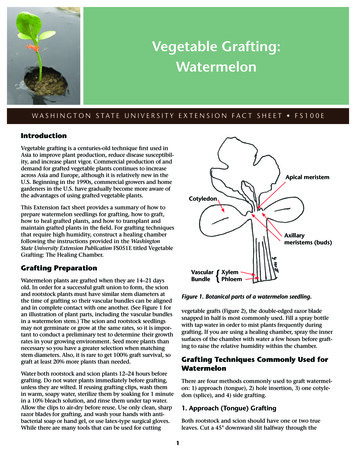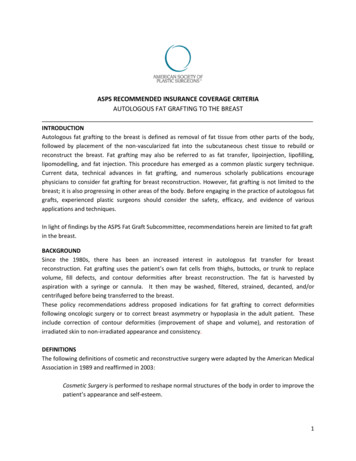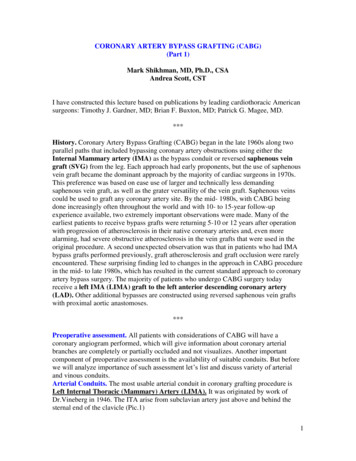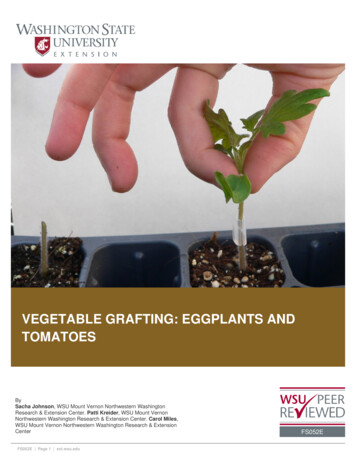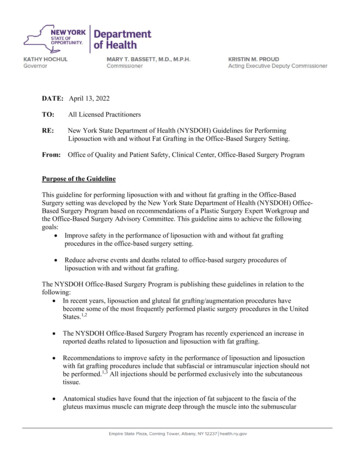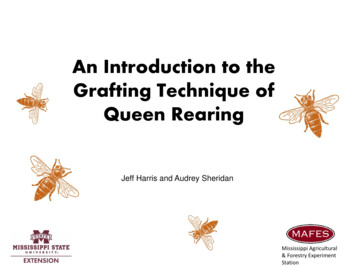
Transcription
An Introduction to theGrafting Technique ofQueen RearingJeff Harris and Audrey SheridanMississippi Agricultural& Forestry ExperimentStation
Outline of Queen Rearing Larvae of known age from parent colony Queen cells initiated in a CELL STARTERduring first 24 hours Queen cells ripened and matured in aCELL FINISHER Cells harvested to mating nucs
egglarvapupaQueen(16 days)egglarvapupaWorker(21 days)egglarvapupaDrone(24 days)
Key IngredientsSwarming seasonYoung beesGood nectar and pollen flowDay oldLarvae
How to get the correct aged larva 1 to 3-frame enclosure Use excluder to “enclose” queen on 3frames Forces her to lay on a predeterminedframe Easy to know the age of larva 1-frame is difficult for safe removal offrame (Queen) Push in cage Use # 5 hardware cloth to isolate queenon specific area of frame You can control the maximum number ofeggs/day Easy to know the age of larva Must release the queen the next day
Eggs of known age produced by queen on a schedule.
1 to 1 ½ day old larvae needed for graftingLarvae that have just hatched from eggs are the best.
Keep the worker bee density as high as possible.
Cell BuilderHoneySealed broodPollenSealed broodGrafted CellsSealed Brood orempty combHoney
Grafting Method(based on methods of Gilbert M. Doolittle)
QR Day 1graftegg01QR Day 7pupateslarva234567QR Day 12emergencepupa891011121314 1520-25th day – orientation and mating flights (QR Days 18-23)25-30th day – queen begins egg-laying (QR Days 23-28)16
Grafting
Tools of the Trade—Queen CupsNicot SystemJZBZ System
Cells can be placeddirectly on frameYou can make your owncells with a 5/16 “ dowel
Grafting - the transfer of larva into queen cell cups. Graft the smallest larva possible 18-24 hr old are best Plastic or Wax cell cups Many different grafting tools to choose from -Chinese grafter, master grafter, modified bicycle spoke, toothpickSpecial Techniques ‘Dummy’ graft (to harvest jelly) Double graft (use the first graft to prime cells for the ‘real’ graft) Dry graft (no priming of queen cup)
GraftingStep by Step1. Correct age larva from breeder2. Grafting location- Sturdy table with good lighting3. Climate controlled room- Temperature and Humidity4. Prepare cell builders ahead of time5. Prepare cell bars ahead of time6. Graft larva and place into cell builder asquickly as possible
How to get the correct aged larva 1 to 3-frame enclosure Use excluder to “enclose” queen on 3frames Forces her to lay on a predeterminedframe Easy to know the age of larva 1-frame is difficult for safe removal offrame (Queen) Push in cage Use # 5 hardware cloth to isolate queenon specific area of frame You can control the maximum number ofeggs/day Easy to know the age of larva Must release the queen the next day I killed a fast moving queen this way
These larvae (5 days old) are way too old for grafting.
A larva of perfect age being transferred into cell cup.
Microscopes or magnifying lenses aid in grafting,but REAL beekeepers use the naked eye!
Royal jelly can be purchased or harvested.
1. Queen cells aged 3-4days yield the mostjelly2. Dilute jelly 50:50with distilled water3. Freeze mixture untilneeded for grafting4. Prime each cell cupwith a small drop ofmixture beforetransferring a larvainto it
Cell cups can be primed by ladling or pipetting.
When you do it rightWhen you don’t
Where do the cells go now? Best place is a mating nuc. In an incubator, isolated cages or vials. To a friend who needs cells (transport ina thermos, etc.)
Grade the cells before you use them
How do I place the queen cell?
Miksa Honey FarmsHoney Run Apiariesportable cell incubatorHome Madecell incubatorsSteven Coy’s need it nowwhere’s the cordless drill , screws, flatwashers, rubber straps and screen wire,carbon neutral Portable IncubatorIt’s bee heated/cooled
TroubleshootingWhen things don’t turn out so great
Don’t expect to have consistently good takewhen you first learn grafting typical is about10% take on the first go.Do make a lot more grafts than you need. Asingle-story cell builder can support about 60grafts, but you can double this amount whenfirst starting.
Open Hatch:A successfulemergencePhoto by Kelly Gillette
Problem:One or two queens emerge, the restof the cells are torn down
Cause:Graftedlarvae arenot thesame age
Problem:IntercasteQueen
Cause:Larvae too old attime of grafting
Problem:Cells torn downPhoto by Kelly GilletteCause:Dead queen or a queenalready presentPhoto by Kelly Gillette
Hygienic workerswill tear downand remove adead queen.Photo by Kelly Gillette
Queen death likely dueto viral infection, i.e.Deformed Wing VirusPhoto by Kelly GillettePhoto by Kelly Gillette
Problem:All cells are started, then someare torn down.
Photo by Kelly Gillette
Cause:Poor nutrition in the cell builder;diseased or dying larvae
Problem:BurredQueenCells
Cause:Natural impulse to makecomb and store syrup
If you pull your cells early from the cell builder,be sure to incubate them at the propertemperature (93 F) and humidity (50-70%) orqueens may not finish developing!
If in doubt You can carefully open queen cells thathave not emerged on their due date.
Special Techniques 'Dummy' graft (to harvest jelly) Double graft (use the first graft to prime cells for the 'real' graft) Dry graft (no priming of queen cup)


